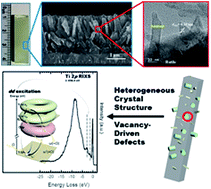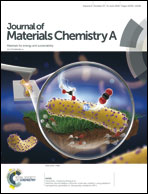A facile route for the synthesis of heterogeneous crystal structures in hierarchical architectures with vacancy-driven defects via the oriented attachment growth mechanism†
Abstract
One-dimensional rutile TiO2 nanorod arrays with a tunable morphology and intact crystalline sub-nano structures attached are successfully fabricated as a large-scale film based on substrates. An anatase/rutile TiO2 crystal structure grown in a hierarchical architecture is achieved by forming hybrid organic–inorganic interfaces in a solvent-based environment. The oriented attachment growth dominant pathway provides an easy and reproducible method to synthesize unnaturally shaped nanostructures with heterogeneous crystalline structures, the co-existence of which is difficult in one-dimensional array systems. The morphology and crystal structures of the attached sub-nano nanoparticles are also highly related to the solvent composition ratio due to the hydrolysis–condensation reaction. The small misorientation between the lattice planes of the two distinct phases leads to the formation of interface dislocations, which are assigned as oriented attachment growth-induced defects. Resonant inelastic X-ray scattering reveals that the obvious dd excitation feature of the TiO2 nanorod arrays after the sub-nano structure attachment is related to the growth-induced oxygen vacancies, which demonstrates the existence of Ti3+ at the interface. The interface Ti3+ can activate the Ti–OH species, resulting in an enhancement in photocatalytic activity. TiO2 nanorod arrays based on substrates with heterogeneous crystal structures and remarkable crystalline stability have potential as promising photocatalysts in the energy and environmental fields.



 Please wait while we load your content...
Please wait while we load your content...